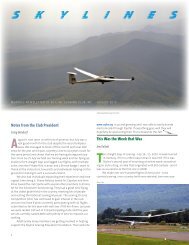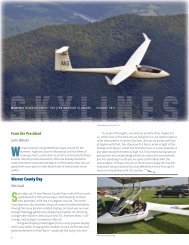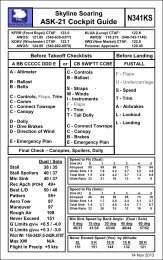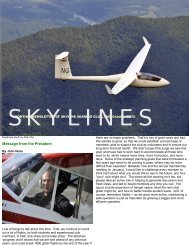Message from the President - Skyline Soaring Club
Message from the President - Skyline Soaring Club
Message from the President - Skyline Soaring Club
You also want an ePaper? Increase the reach of your titles
YUMPU automatically turns print PDFs into web optimized ePapers that Google loves.
hurried, patient with our questions and informal. At <strong>the</strong> end we got<br />
to talking about families and it emerged that he is as enthusiastic<br />
about his two adopted sons as he is about <strong>the</strong> works of Windward.<br />
He and his wife, Neva, journeyed to <strong>the</strong> fur<strong>the</strong>st outreaches of<br />
nor<strong>the</strong>ast Siberia (seven hours <strong>from</strong> Vladivostok) to pick <strong>the</strong>m up<br />
<strong>from</strong> an orphanage. He talked about how he and Neva went over<br />
<strong>the</strong>re “all in.” They were fully committed to adopting <strong>the</strong> boys even<br />
before first meeting <strong>the</strong>m. The story of <strong>the</strong> previous life of <strong>the</strong>ir<br />
sons, who are bro<strong>the</strong>rs, is tragic. It has been <strong>the</strong> thrill of a lifetime<br />
to watch <strong>the</strong>m make <strong>the</strong> slow and still, after two years, difficult<br />
transition into <strong>the</strong>ir new lives. It has been a series of challenges<br />
for Greg and Neva, but one <strong>the</strong>y enjoy and are dedicated to. It<br />
was clear to us that Greg has as much to look forward to when he<br />
goes home after a day at Windward as he does in <strong>the</strong> morning<br />
going back to work.<br />
A Quick Tour of <strong>the</strong> PowerFLARM<br />
gaggle). However, if <strong>the</strong>y change course and a collision threatens,<br />
it will <strong>the</strong>n alert both pilots of <strong>the</strong> impending problem. Similarly, two<br />
gliders relatively far apart but pointed towards each o<strong>the</strong>r and<br />
moving quickly will result in an alert going off at a fair distance,<br />
typically enough to give <strong>the</strong> pilots 20 seconds to take action.<br />
This advanced and intelligent technology makes FLARM <strong>the</strong> most<br />
interesting part of what PowerFLARM offers. Unfortunately,<br />
PowerFLARM is <strong>the</strong> only device available in <strong>the</strong> US which speaks<br />
FLARM, and so <strong>the</strong> odds of ano<strong>the</strong>r glider also being equipped<br />
with FLARM is remote. This capability remains somewhat<br />
<strong>the</strong>oretical for now, although I anticipate that it will proliferate<br />
rapidly in contests and o<strong>the</strong>r places where close-quarters flying is<br />
common. I certainly hope it will, at least, because this technology<br />
will save lives if widely adapted.<br />
ADS-B<br />
By Mike Ash<br />
The PowerFLARM is an exciting new anti-collision device now<br />
available for gliders in <strong>the</strong> US. Jim Kellett and I pre-ordered one<br />
when <strong>the</strong>y were first announced about two years ago, and after<br />
many delays, we finally received our unit this summer and got it<br />
installed last month.<br />
What exactly is PowerFLARM It's actually three anti-collision<br />
devices in one. It includes <strong>the</strong> proprietary FLARM technology,<br />
developed specifically for gliders and light aircraft in Europe, as<br />
well as an ADS-B receiver and <strong>the</strong> equivalent functionality to a<br />
PCAS device.<br />
FLARM<br />
The FLARM functionality is simultaneously <strong>the</strong> most and least<br />
interesting part of <strong>the</strong> device. A FLARM device contains a GPS<br />
receiver and a low-power digital radio. The FLARM unit broadcasts<br />
its current position, as determined by <strong>the</strong> GPS, as well as a<br />
prediction of its flight path out to about 20 seconds into <strong>the</strong> future.<br />
O<strong>the</strong>r FLARM receivers within a few miles will receive <strong>the</strong>se<br />
broadcasts. They can compare <strong>the</strong> o<strong>the</strong>r traffic's position and<br />
predicted course with <strong>the</strong>ir own, and sound <strong>the</strong> alarm if it looks like<br />
a collision is imminent.<br />
FLARM was designed <strong>from</strong> <strong>the</strong> start with gliders in mind. It<br />
understands <strong>the</strong> kind of flying we do, and is smart enough to avoid<br />
sounding an alarm when two gliders are nearby but not on a<br />
collision course (e.g. hanging out happily on opposite sides of a<br />
In addition to FLARM, <strong>the</strong> PowerFLARM device also features an<br />
ADS-B receiver. ADS-B is conceptually a bit like FLARM, except<br />
higher powered and without <strong>the</strong> advanced flight path prediction<br />
and collision-avoidance smarts. It's eventually intended to be <strong>the</strong><br />
primary surveillance technology in US airspace, although adoption<br />
is not moving particularly quickly. It's hard to find aircraft equipped<br />
with an ADS-B transmitter in <strong>the</strong> US at <strong>the</strong> moment, but for those<br />
that exist, PowerFLARM will detect <strong>the</strong>m and provide collision<br />
alerts much like <strong>the</strong> FLARM functionality.<br />
Transponders<br />
Since most aircraft in this country don't have ei<strong>the</strong>r FLARM or<br />
ADS-B, <strong>the</strong> PowerFLARM provides a final fallback mechanism in<br />
<strong>the</strong> form of a PCAS-like system. This system simply detects<br />
transmissions <strong>from</strong> <strong>the</strong> radar transponders which have been a<br />
feature of <strong>the</strong> air traffic control system for decades. Note that it<br />
does not interrogate transponders, which would require a far larger<br />
and more expensive box. It requires some o<strong>the</strong>r source of<br />
interrogations, such as a ground radar facility or an airliner's TCAS<br />
system. We're never far <strong>from</strong> such a source where we fly, as <strong>the</strong><br />
airliners going overhead are constantly interrogating nearby<br />
transponders.<br />
Transponders provide altitude, but not position or range. Radar<br />
systems figure out position and range by moving <strong>the</strong>ir antenna and<br />
timing <strong>the</strong> delay in responses. The PowerFLARM doesn't have this<br />
luxury, as it's an entirely passive device when it comes to<br />
transponders. Because of this, it can tell how high a transponder<br />
target is (and thus how far away <strong>from</strong> your own altitude it is), but it<br />
can't precisely determine whe<strong>the</strong>r it's a collision threat. The<br />
PowerFLARM makes a rough guess at distance based on <strong>the</strong><br />
signal strength. As <strong>the</strong> remote transponder gets closer, it also gets<br />
louder, and <strong>the</strong> PowerFLARM will use this to guess at how far<br />
away it might be. When it comes to direction, <strong>the</strong> PowerFLARM<br />
has no idea whatsoever. When a transponder-based collision alert<br />
sounds, it will tell you whe<strong>the</strong>r you need to look up, down, or level,<br />
and give you some idea of <strong>the</strong> distance, but it's up to you and your<br />
trusty eyeballs to scan your surroundings and find <strong>the</strong> thing.<br />
Despite <strong>the</strong> limitations, <strong>the</strong> PowerFLARM still shows <strong>the</strong> same<br />
smarts with transponders as with <strong>the</strong> o<strong>the</strong>r systems. If <strong>the</strong> altitude<br />
separation isn't converging, <strong>the</strong>n it won't sound an alarm. Likewise<br />
if <strong>the</strong> target's distance is holding steady or increasing. Only targets<br />
which are closing and at or moving toward a similar altitude trigger<br />
an alarm.<br />
Additional Functionality<br />
Besides its primary role, <strong>the</strong> PowerFLARM can also provide GPS















